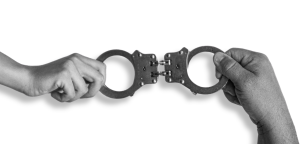The real world is scary
The thought of being in the middle of a crowd full of strangers may feel scary and nerve-wracking for many people after the last year of social isolation.
May 19, 2021
Due to the CDC’s recent announcement that vaccinated people may safely forgo masks, society continues to edge closer and closer to the pre-pandemic circumstances. While this should clearly be a cause for celebration, it is also understandable how the prospect of returning normalcy elicits dread in those who have become accustomed to a comfortable, virtual life. A summer filled with real-life events and gatherings is on the horizon, which means it’s time to re-learn how to be social.
In the past, post-isolation anxiety has primarily been a concern for people who are all of a sudden tasked with re-entering the civilian world after being released from prison, being deployed during wartime or returning from some other remote location. Feelings of stress and anxiety have been found to often accompany such transitions. Today, we are all experiencing a similar situation: being forced to re-assimilate into a culture that seems almost foreign. For some, the fear arises based on concerns over spreading or receiving the virus; the thought of spending time with family and friends used to have (mostly) positive connotations, but now there is ever-present the threat that these people could have COVID-19. However, the reality is that simply re-entering a socially active world can be just as intimidating.
“It’s normal for people to feel anxious about adapting to more changes, including meeting in person again,” says Bethany Teachman, PhD, a psychology professor at the University of Virginia. “There’s a tendency to take a situation that’s ambiguous or uncertain and assign a really threatening, negative meaning to it.” For introverts and extroverts alike, imagining standing shoulder-to-shoulder amidst a crowd of mask-less people feels unfamiliar and threatening. Learning to avoid close contact with anyone and everyone over the last year has elicited feelings of apprehension for everyone, even for those who are excited to be social again. We have all been taught not to trust strangers, to label everyone as a potential virus-carrier, and that internal alarm is not something we can easily turn off, especially when it is an entirely unconscious reaction.
Learning to function properly in a social environment is something that we have to be taught. That’s what preschool is for, after all: to develop prosocial interaction skills so that we can survive in the situation of being surrounded by hundreds of peers. After all this time, it is safe to say that without consistent utilization of such skills they have begun to fade away—at least that’s what it feels like. Perhaps another explanation is that they are still there, and everyone is more than capable of picking up where they left off when it comes to interacting with friends or even strangers, but the motivation is just lacking. Quarantine has been a time to become comfortable with your own company, and the result has been a little too much enjoyment in spending time alone. Why threaten such feelings of content by adding more obnoxious people back into the equation?
Whatever the reason, no one should be afraid to admit that they feel a little anxious about being social again. It’s completely understandable why suddenly jumping back into a world where large gatherings are acceptable feels scary and overwhelming. If as a community we can validate these feelings in each other, then hopefully we can all acclimate to this new normal in a healthy way and find enjoyment in our social lives once again.









